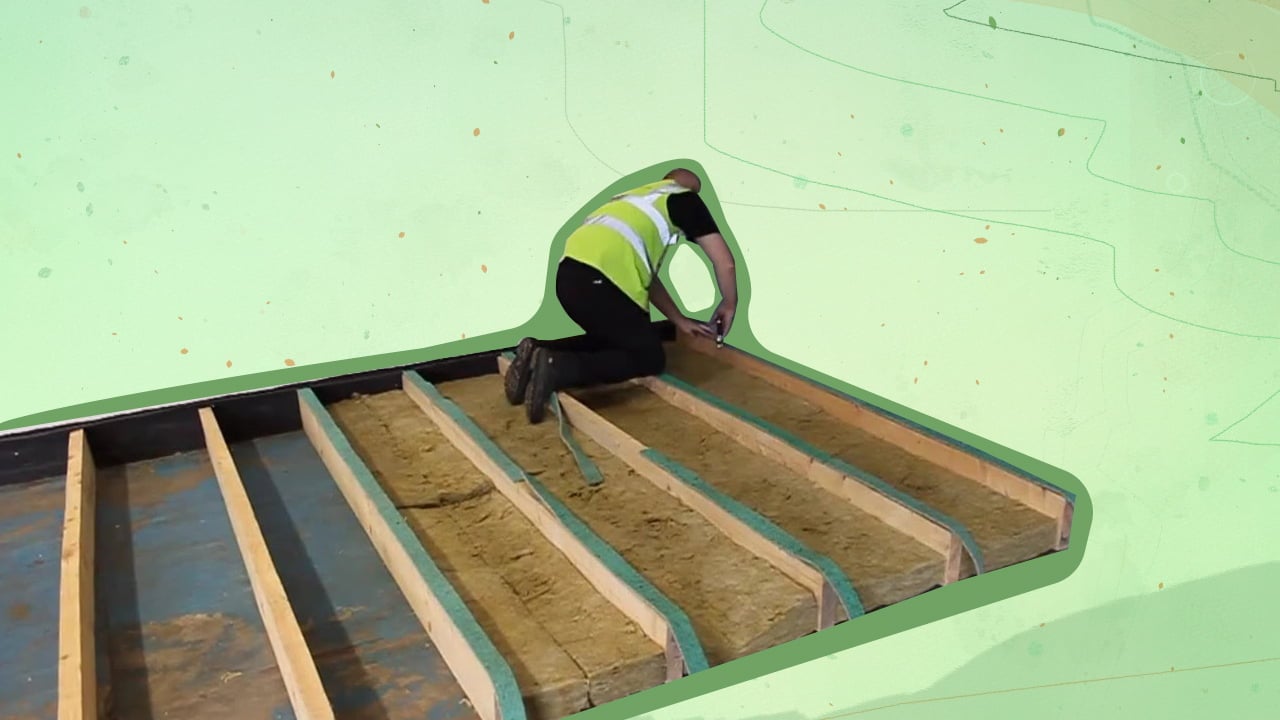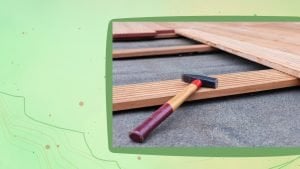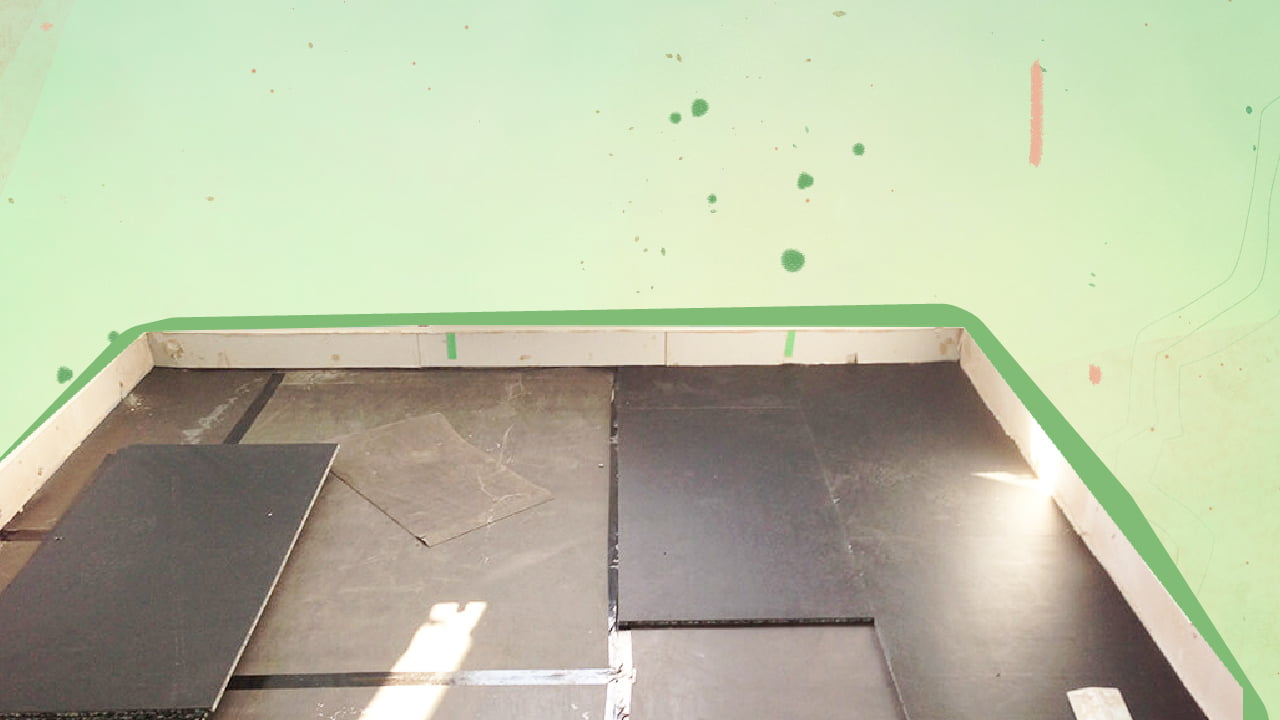 Reviewed by
Anton Giuroiu
Reviewed by
Anton Giuroiu
You can soundproof your floor during installation or after it has been finished. Before installation underlayment, floor joist isolators, or dense acoustic insulation can be used while after installation you can use carpets, rugs, mats, and even proper furniture placement to minimize sound. Another popular method is to remove structural noises by replacing old screws and pins.

Tired of hearing noise complaints from your neighbors living downstairs? Well, it’s time that you make your floor soundproof.
Everyone likes to have peace and solitude at home, so you can’t really blame your neighbors if they complain about noises coming from your room.
Thankfully, by making your floor soundproof, you can avoid such complaints altogether. So, how can you soundproof the floor of your house? That’s what I have discussed here, so dive in!
How to Soundproof Floors

Soundproofing Basics
Before I delve deeper into the topic, let me give you a brief idea about what soundproofing is. Simply put, it is a process that aims to minimize or eliminate sound propagation. If you soundproof a room, you can prevent noises from leaving the room. The opposite is also true, which means that you won’t have to deal with any external noises.
Besides the floor, you can soundproof any part of your room. For instance, if you soundproof the walls, you can prevent noise from propagating through them. This means that people living in the adjacent room will not be bothered by noises coming from your room. Similarly, if you soundproof the ceiling, you won’t have to worry about the upstairs neighbors disturbing your sleep in the middle of the night.
In this regard, soundproofing is done to eliminate two types of noise - impact noise and airborne noise. The former is caused due to impacts, while the latter is caused by ambient sounds. For example, if you hit your walls with a hammer, it will generate impact noise. On the other hand, if you are playing loud music, the sound will travel as airborne noise.
Impact noises are normally more troublesome than airborne noises since the energy of an impact vibration can propagate quicker than ambient noise. Furthermore, the noises generated from impacts are a lot louder and more difficult to manage than the noises generated by a barking dog or talking people. This is because the vibrations from an impact travel directly through the materials of the walls and ceilings.
If it is a bit difficult to understand, then refer to the infographic below. It demonstrates how vibrations travel through the walls and floors to generate noise in adjacent areas.

Why Should You Soundproof Floors?
Soundproofing is essential because it helps to improve the absorption (acoustics) of sound inside a room. Many homeowners understand the necessity of soundproofing their walls and ceiling, but when it comes to the floor, they feel skeptical, especially if they live on the first floor.
Yeah, I admit that If you live on the lowermost floor, then it might not always be necessary to soundproof your floors. However, if there is living space below you, then floor soundproofing is required.
Besides, soundproof flooring is not just meant to reduce the noise nuisance for your neighbors. It is also required to improve the impact insulation class (IIC) rating of the floor. This, in turn, contributes to the sound transmission class (STC) rating, which is a mandatory requirement under the law.
According to the International Building Code 2021, the STC rating of a building needs to be above 50. Therefore, if you want your home to be legally compliant with the regulations, soundproofing floors is a must.
In that context, different types of floors require varying levels of soundproofing based on their sound transmission capabilities. For instance, floors made of stone or ceramic tiles transmit a lot more noise than floors made of hardwood or concrete slabs. Thus, you will need more soundproofing materials for insulating a tile floor than what you will need for soundproofing hardwood flooring.
That said, the overall procedure is more or less the same, regardless of the flooring type. You just need to decide when you want to soundproof your floor. That’s because the methods to soundproof finished floors are different from the methods implemented during floor installations.

How To Soundproof An Existing Floor?
There are many ways in which you can soundproof an existing floor, as you can see below.
1. Laying Carpets And Rugs
The simplest method to soundproof a finished floor is to use wall-to-wall carpeting. If you use a carpet on your tile or stone floor, it can efficiently absorb the sound from impact, thanks to the shag. Besides, it minimizes the force of impact, which prevents the items from breaking when they are dropped, which is an additional advantage.
If you want to reduce the impact noise in certain sections of the floor, you can use rugs, which are usually smaller in size than carpets. As a matter of fact, using rugs below your heavy furniture is an excellent idea, as it minimizes the impact of noise when you move them.
On that note, moving furniture becomes much easier if there is an underlying rug. Instead of carrying or dragging the furniture item across your floor, you can simply pull it with the rug, which requires considerably less effort. So, not only does it reduce unwanted noise, but it also increases convenience, which makes it an excellent pick for finished floors.
Installing carpets or rugs on your floor is pretty straightforward, which is another advantage of this option. All you need to do is roll it over your floor, and you will be good to go.
However, you need to measure the dimensions of your floor beforehand, especially for a wall-to-wall carpet that covers the whole floor. If you don’t, you will end up with uncovered areas on the floor that lack soundproofing.
You need to consider the thickness of the carpet or rug you want as well. A thick carpet can absorb more noise but is relatively expensive to get. On the other hand, a thin carpet is a lot cheaper, but it can absorb less noise by comparison.
2. Using Mats
Using floor mats is another method for soundproofing a finished or new floor. The basic principle is very similar to the one used for the carpets and rugs, as you need to lay them over your existing floor to make it soundproof. Even so, there are certain differences with this option that need to be considered.
The first and most obvious difference is the materials used. Typically, the shags of carpets and rugs are made from wool, cotton, or nylon. In contrast, soundproofing mats are made from rubber, cork, vinyl, plastic, or composite materials.
Natural rubber is an excellent material for sound insulation, which is why it is commonly preferred over other soundproofing materials. You can easily use rubber mats over your floor to minimize impact noise and ambient noise. Likewise, they can be used as carpet padding below your carpets to enhance their soundproofing capabilities.
Composite mats are generally made from a combination of wood, fiber, and plastic. They are pretty thick, which helps to absorb sound efficiently. On the flip side, they are expensive, which reduces their feasibility.
Regardless of the materials, most floor mats are available in two forms - rolls and interlocking tiles. This is another aspect that differentiates them from carpets, which are only available in a single form.
The rolls are similar to a rug, and you need to lay them over your floor. However, a roll of rubber mat is relatively large and heavy, which can make it slightly difficult to handle.
If you do not want to deal with that hassle, you can go with an interlocking floor mat. Installing it is much easier by comparison and feels a lot like solving a jigsaw puzzle. Besides, interlocking floor mats are available in different color options, which helps to improve the floor aesthetic.
3. Install Deck Screws And Nail (Fastener)
This is a method that is primarily used for wooden and hardwood floors. Such floors are generally made from wooden floorboards that are held together with adhesives or fastener nails.
In many cases, the adhesive wears off over time, or the nails become rusty and corroded. Ultimately, they come loose from the floorboards, which causes the floorboards to become squeaky. Squeaking sounds are a result of the floorboards rubbing against each other, and hence they can be considered to be a structure-borne noise.
If you want to eliminate the squeaking sounds (or any other structural sound, for that matter), you should install new deck screws. That will restore the integrity of the wood flooring and get rid of any odd structural noises.
To install the deck screws and nail (fastener), you will first need to remove the old nails and adhesives if they haven’t come off already. You can use a claw hammer to pry out the old rusted nails from the wooden floorboards.
In some situations, the rust may cause the nails to become stuck to the boards. If you come across such nails, you can use rust remover to loosen them up for easier removal.
Likewise, you can remove the old adhesives by scraping them off with a brush or sandpaper. You can also use vegetable oils to remove old adhesives. First, you have to pour the oil over the adhesive and let it soak for a while. Then you have to wash it off with water or wipe it with a clean cloth.
After that is done, you can install the new screws and nails. For the screws, you can install them with a screwdriver, and for the nails, you can use a simple hammer.
4. Furniture Placement
Have you ever wondered why an empty room sounds louder than a filled-up room? It is because objects, such as furniture, are good absorbers of sound. Therefore, you can make the floor (and, by extension, the room) soundproof by placing your furniture items in a specific manner.
Such a system is highly effective for blocking out airborne sounds. And with correct placement, you won’t have to worry about dropping objects on the floor either. For instance, if you have more than one table in the room, then a dropped item will likely fall on them instead of the floor, thereby eliminating impact noise.
As you can guess, there is no installation necessary for this method. All you need to do is move your furniture to the noisiest parts of the room, such as near your TV or music system. That will effectively soundproof your room for listening to music or watching movies loudly.
On that note, you can use this technique to soundproof an existing wall by placing the furniture items close to this wall.
However, one disadvantage of this method is that you will need lots of furniture to get the maximum level of soundproofing. If you have enough furniture in your apartment, it shouldn’t be a problem. But if you don’t, then it would not be feasible to buy furniture just to soundproof the floor. In that situation, you can opt for another soundproofing method.
Tip
I recommend using cushioned furniture items, such as sofas, couches, mattress beds, and so on. The cushioning on these items can absorb sounds better, thereby giving you a quieter experience.
How To Soundproof Floors During Installation?
It is always better to soundproof a floor when it is being installed. You don’t have to take my word for it, though; just ask any construction engineer, and they would suggest doing the same.
There is a good reason for this - the features of a floor under construction can be easily adjusted or modified to accommodate soundproofing measures. You cannot do such modifications with a finished floor unless you want to demolish and rebuild it again.
With that in mind, here are some methods that can be used to soundproof a floor during installation.
1. Use Underlayment
Floor underlayment is a layer of insulating material that is placed either below or just above the flooring material. They are typically used to provide thermal or acoustic insulation. The former helps with regulating room temperatures, while the latter is used for soundproofing.
Acoustic floor underlayment can be made from different materials, as I have listed below.
- Vinyl - Usually consists of compounds like polypropylene or polyvinyl chloride (PVC)
- Rubber - Uses either natural or synthetic rubber and offers excellent soundproofing
- Cork - Works best for tile, stone, cement, or marble flooring
- Felt - Most suitable for hardwood, bamboo, or laminate flooring
- Foam - Made from polypropylene and works best for an engineered or a floating floor
Rubber is the most effective acoustic underlayment, followed by vinyl, which is comparatively cheaper. And the best part is that they can be used for almost any type of floor, which makes them highly versatile.
If you want to underlay them below the flooring materials, you need to place them right over the subfloor. Most underlayments come in the form of rolling sheets, which means that you will need to lay them out like a carpet over the subfloor surface.
After that, you have to apply adhesives to fix them in place. I recommend using an acoustic caulk or Green Glue due to their innate soundproofing capabilities. If the underlayment roll comes with pre-applied adhesive, though, this step can be skipped.
In any case, once they are secured, you need to fill out any gaps using a sealant. Following that, you can lay down the flooring material to complete the installation. You have to use adhesives to glue these materials in place. However, if you intend to use floor lamination or a floating floor, that won’t be necessary.
2. Use Dense Acoustic Insulation
Below the floor surface lies the sub-floor, and underneath that lies the ceiling drywall of the room below. In this regard, the space between the subfloor and the ceiling drywall can be stuffed with dense insulating materials, such as foam. This is just what you need to do here, and it will muffle most impact and airborne sounds from traveling through the floor.
Most buildings contain some level of sound insulation between these layers. Although, if you want better soundproofing, you can add more insulation. Simply stuff the hollow space with the insulating material, and then you can move on to the rest of the floor installation. But make sure not to use too much stuffing, as it may make it difficult to attach the subfloor.
3. Soundproof The Floor Joists
A floor joist is a structural component that lies below the subfloor. It bears the weight of the whole floor and everything that lies above it. So, it is essentially a load-bearing structure, similar to pillars.
In that context, if you soundproof the joists of your floor, you can eliminate all sound transfer through the floor. The best strategy for this purpose is to use floor joist isolators. They are thick pieces of rubber that are usually placed between the floor joists and the subfloor. This creates a gap between them, which prevents sound from propagating.
As for the installation of these joist isolators, you need to slide them in place over the joist frames carefully. Then, you can nail the subfloor in place and install the rest of the flooring components over it.
The gap created by an isolator also acts as a thermal and vapor barrier which prevents the entry of moisture and keeps the floor temperature under control.
What Is The Cost Of Soundproofing The Floor?
When thinking of getting a soundproofed floor, the cost is possibly the first and foremost thing to pop into mind. And to be honest with you, there is no simple answer to this question.
While the materials used for soundproofing do not cost a lot of money, the procedure for getting it done is a bit costly. This is especially true if you want to get the floor soundproofed during installation. Such processes require skilled labor, which is often expensive.
The costs for soundproofing also depend on the size of your room. If your apartment is a small one, you can get it done without straining your bank account. However, if you have a large apartment or home, you might need to shell out a lot of cash. Personally, I would not suggest going for full soundproofing in that case unless you can bear the costs.
That said, some options, such as buying carpets or mats, are considerably cheaper. So, if you have a tight budget, you can consider these options instead.

Soundproofing Floors Final Words
Soundproofing your floor is not just a matter of convenience - it helps maintain your privacy too. I mean, would you really want your neighbors to hear your private conversations? Of course not!
Thus, to make it easier for your neighbors and yourself, you should make the floor soundproof right away. And if possible, you should get your walls, ceiling, doors, and windows insulated as well.
Anyways, that brings me to the end of this detailed guide. I hope you find the information here to be helpful.
See you around then!
